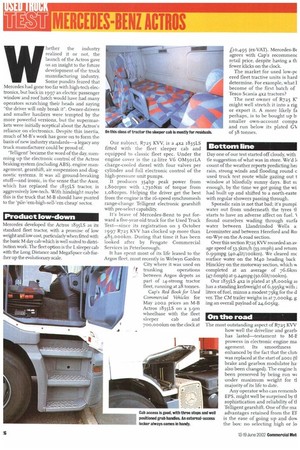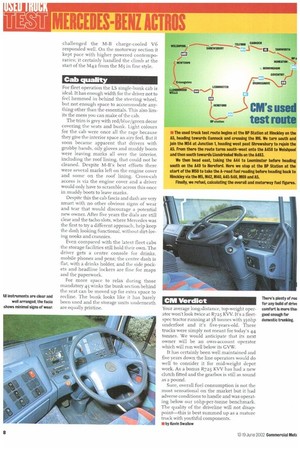ilif hether the industry realised it or not, the launch
Page 26

Page 27

Page 28

If you've noticed an error in this article please click here to report it so we can fix it.
of the Actros gave us an insight to the future development of the truck manufacturing industry. Some pundits feared that Mercedes had gone too far with high-tech electronics, but back in 1997 an electric passenger window and roof hatch would have had many operators scratching their heads and saying "the driver will only break it". Owner-drivers and smaller hauliers were tempted by the more powerful versions, but the supenriarkets were initially sceptical about the Actros's reliance on electronics. Despite this inertia, much of M-B's work has gone on to form the basis of new industry standards—a legacy any truck manufacturer could be proud of.
'Telligent' became the word of the day, summing up the electronic control of the Actros braking system (including ABS), engine management, gearshift, air suspension and diagnostic systems. It was all ground-breaking stuff—and ironic, in the sense that the Axor, which has replaced the 1835LS tractor, is aggressively low-tech. With hindsight maybe this is the truck that M-B should have punted to the `pile-'em-high-sell-'em cheap' sector.
Product low-down
Mercedes developed the Actros 1835LS as its standard fleet tractor, with a promise of low weight and low cost, particularly when fitted with the basic M day cab which is well suited to distrikition work. The fleet option lathe L sleeper cab with the Long Distance and MegaSpace cab fiirther up the evolutionary scale. Our subject, R725 KVV, is a 4x2 1835LS fitted with the fleet sleeper cab and equipped to classic fleet spec. Under the engine cover is the 12-litre V6 0M5oi LA charge-cooled diesel with four valves per cylinder and full electronic control of the high-pressure unit pumps.
It produces 354hp peak power from 1,80orpm with 1,73oNm of torque from Lo8orprn. Helping the driver get the best from the engine is the 16-speed synchromesh range-change Telligent electronic gearshift with pre-select capability.
It's brave of Mercedes-Benz to put forward a five-year-old truck for the Used Truck Test—since its registration on 3 October 1997 R725 KVV has clocked up more than 485,000lcm. During that time it has been looked after by Fengate Commercial Services in Peterborough.
It has spent most of its life leased to the Argos fleet, most recently in Welwyn Garden City where it was used on
trunking operations between Argos depots as part of 14-strong tractor fleet, running at 28 tonnes.
Cap's Red Book for Used Commercial Vehicles for May 2002 prices an M-B Actros 1835LS on a 3.9m wheelbase with the fleet
sleeper cab and 700,000km on the clock at f10,495 (ex-VAT). Mercedes-Bt agrees with Cap's recommenc retail price, despite having a th fewer klicks on the clock.
The market for used low-pc ered fleet tractive units is hard determine. For example, what 1 become of the first batch of Tesco Scania 02 tractors?
The next owner of R725 K' might well stretch it into a rig or export it A more likely fa perhaps, is to be bought up b. smaller own-account compa and run below its plated G\ of 38 tonnes.
Bottom line
Day one of our test started off cloudy, with tle suggestion of what was in store. We'd 11 count of the weather reports predicting he rain, strong winds and flooding round c used truck test route while gazing out t window at blissfully sunny days. But st enough, by the time we got going the wi had built up and shifted to a north-easte with regular showers passing through.
Sporadic rain is not that bad; it's pumpi water out from underneath the tyres ft starts to have an adverse affect on fuel. \ found ourselves wading through surfa water between Llandrindod Wells a. Leominster and between Hereford and Ro: on-Wye on the A-road section.
Over this section R725 KW recorded an av age speed of 53.3km/h (33.imph) and return 6.99mpg (40.41it/iookm). We cleared rric surface water on the M4o heading back Hinckley on the motorway section, which w completed at an average of 76.6km (47.6mph) at 9.24mpg (30.61ft/rook:m) OUT 1835LS 4x2 is plated at 38,000kg ai has a standing kerbweight of 6,395kg with ; litres of fuel, minus a modest 75kg for the d ver. The CM trailer weighs in at 7,000kg, g ing an overall payload of 24,60 5kg.
On the road
The most outstanding aspect of R725 KVV how well the driveline and geartp has lasted—testament to M-E prowess in electronic engine ma agement Its smoothness enhanced by the fact that the clut was replaced at the start of 200I (t1 brake and gearbox modulator ha: also been changed). The engine h been preserved by being run wc under maximum weight for ti majority of its life to date.
Any operator who can rememb EPS, might well be surprised by ti sophistication and reliability of tl Telligent gearshift. One of the ma: advantages retained from the EF is the ease of going up and dow the box: no selecting high or lo range or ducking through the gate here— from 2L the driver can progress freely to 8H.
Peak torque of 1.73oNm is on tap from t,o8orpm to 1,4 oorpm, where peak power of 354hp is available. On the longer climbs its quick full gear changes down the box that keep things moving, but it is easy to underestimate how well the Actros can lug down.
The middle section on Dolfor Hill out of Newtown has become something of an acid test for vehicles tackling our used truck route; it seems to have the knack of finding out if the truck can pull its weight or not. In this case 354hp held 38 tonnes in 7L at 1,200rprn. The climb took a second short of eight minutes. Dolfor's alter ego, Dinmore Hill on the A4s to Hereford, is a more conventional climb Here R725 KVV took 2.27min to reach tlu top, breasting at the summit in 6L a 1,400rpm with the driver just holding back or the revs—there was not enough in reserve tc move up to 6H. These hills, and subsequen climbs on the used truck test route, shower how effectively the relatively modest torqut lasted as the crest came into view.
What goes up must come down, and du exhaust brake performed well—as long as i had plenty of revs. It needs arounc 2,000rpm to really kick in, with just a couplt of dabs on the brakes to keep things unde control. The gearbox wil automatically find till right braking gear fo the descent, more ofter than not dropping thre. half gears to start slow ing things down.
Used frequently i should save wear ant tear on the pads; onc the exhaust brake is oi the driver simply knock the gear lever back an, changes down.
When you're runnin at just 9.2hp per tonn you have to expect to b slower through the A road section than mot contenders, but whe challenged the M-B charge-cooled V6 responded well. On the motorway section it kept pace with higher powered contemporaries; it certainly handled the climb at the start of the M42 from the M5 in fine style.
Cab quality
For fleet operation the LS single-bunk cab is ideal. It has enough width for the driver not to feel hemmed in behind the steering wheel, but not enough space to accommodate anything other than the essentials. This also limits the mess you can make of the cab.
The trim is grey with red/blue/green decor covering the seats and bunk. Light colours for the cab were once all the rage because they give the interior space an airy feel, But it soon became apparent that drivers with grubby hands, oily gloves and muddy boots were leaving marks all over the interior, including the roof lining, that could not be cleaned. Despite M-B's best efforts there were several marks left on the engine cover and some on the roof lining. Cross-cab access is via the engine cover and a driver would only have to scramble across this once in muddy boots to leave marks.
Despite this the cab fascia and dash are very smart with no other obvious signs of wear and tear that would discourage a potential new owner. After five years the dials are still clear and the tacho slots, where Mercedes was the first to try a different approach, help keep the dash looking functional, without dirt-loving nooks and crannies.
Even compared with the latest fleet cabs the storage facilities still hold their own. The driver gets a centre console for drinks, mobile phones and pens; the centre dash is flat, with a drinks holder, and the side pockets and headline lockers are fine for maps and the paperwork.
For more space to relax during those mandatory 45 winks the bunk section behind the seat can be moved up for extra space to recline. The bunk looks like it has barely been used and the storage units underneath are equally pristine.
CM Verdict
Your average long-distance, top-weight operator won't look twice at R725 KVV. It's a fleetspec tractor running at 38 tonnes with 35 ohp underfoot and it's five-years-old. These trucks were simply not meant for today's 44 tonnes. We would anticipate that its next owner will be an own-account operator which will run well below its CVW.
It has certainly been well maintained and five years down the line operators would do well to consider it for mid-weight depot work. As a bonus 1(725 KVV has had a new clutch fitted and the gearbox is still as sound as a pound.
Sure, overall fuel consumption is not the most sensational on the market but it had adverse conditions to handle and was operating below our ohp-per-tonne benchmark. The quality of the driveline will not disappoint—this is best summed up as a mature truck with youthful components.
by Kevin Swallow




















































































































































